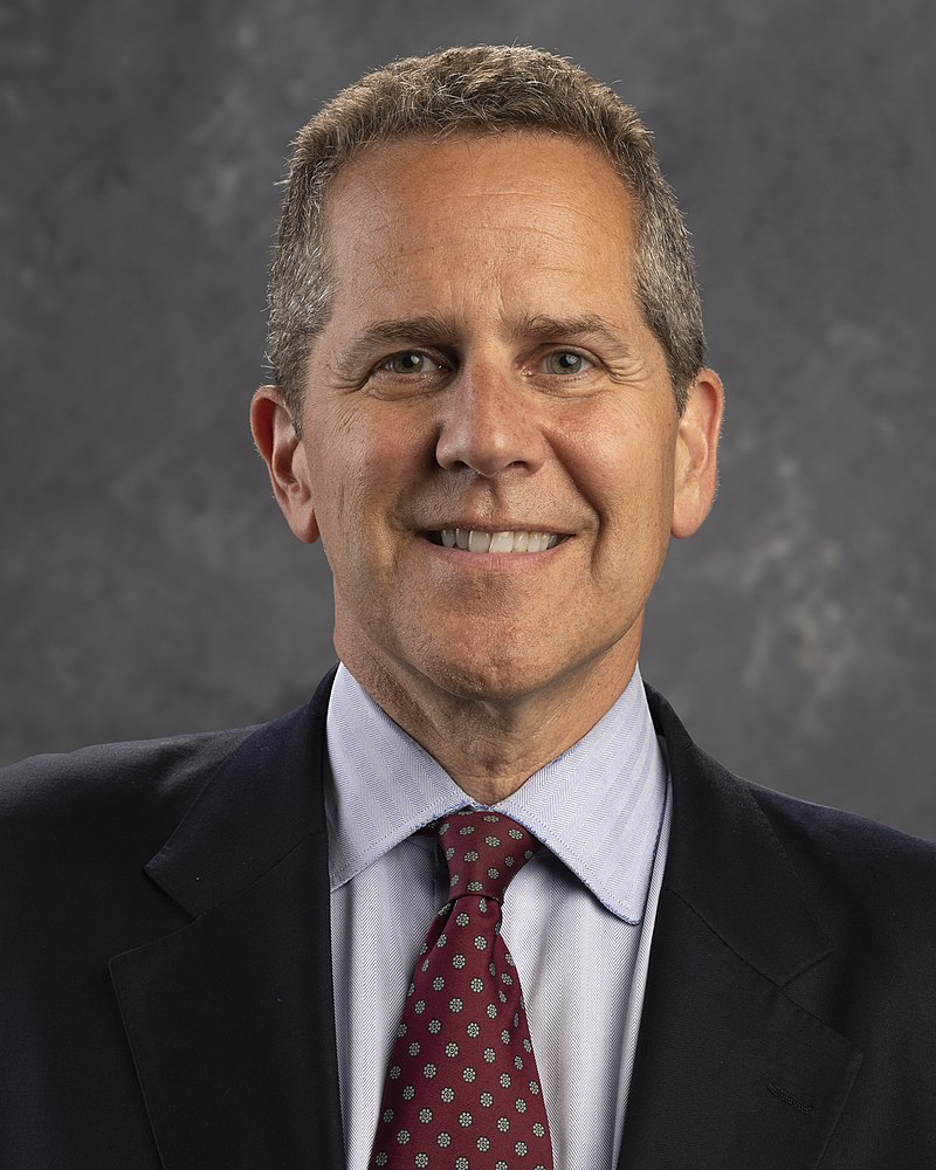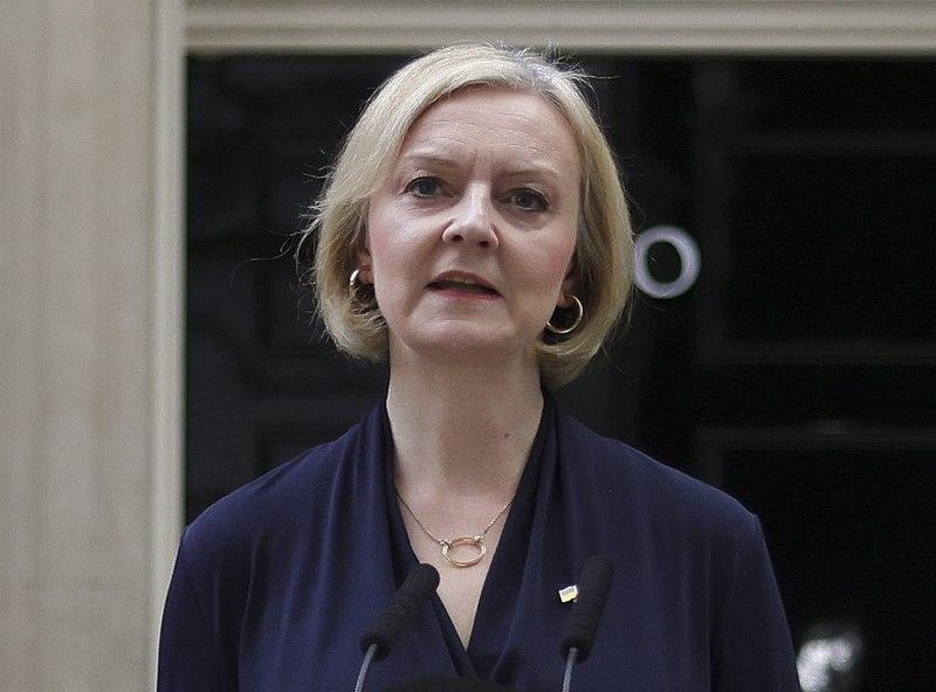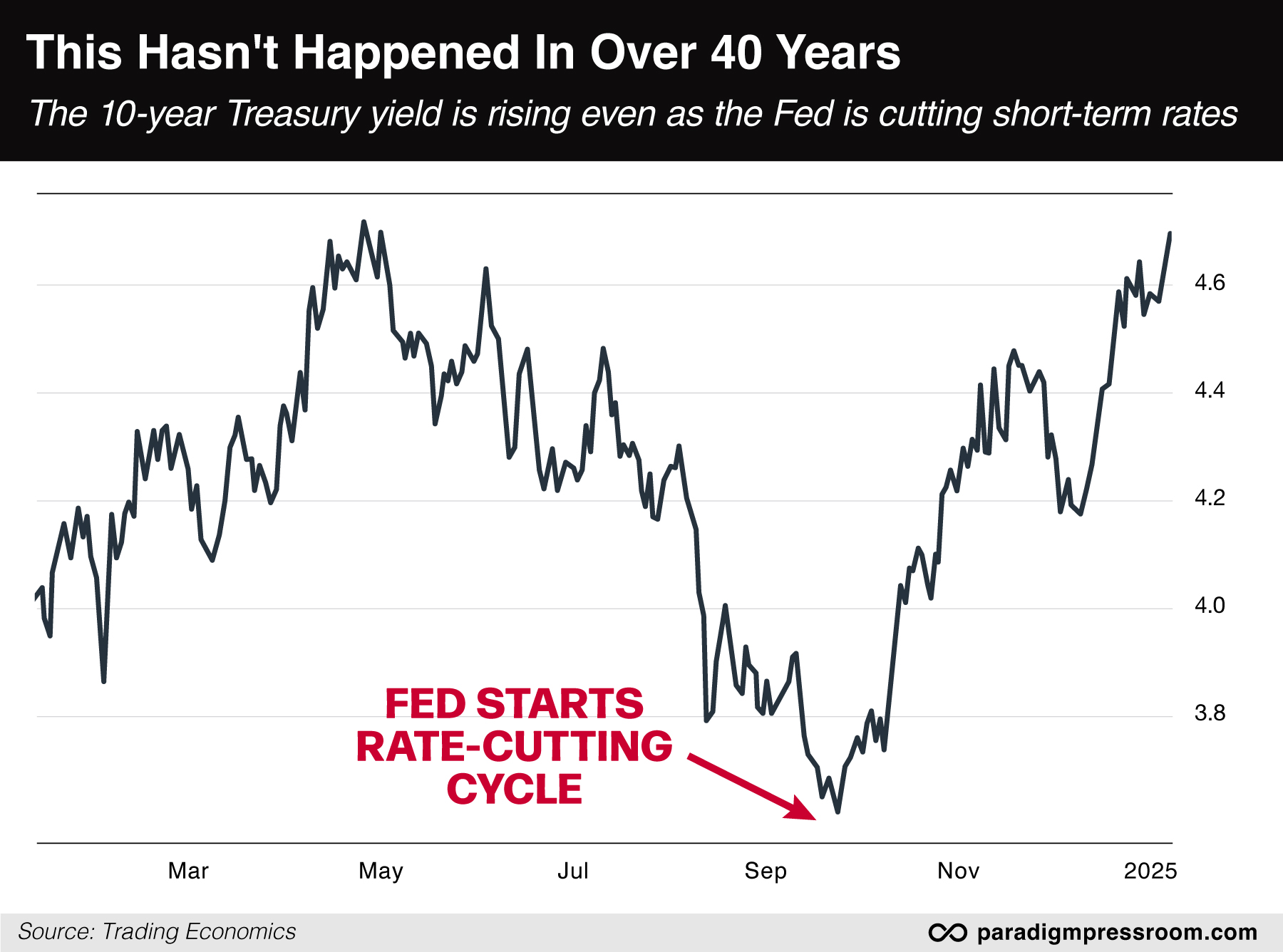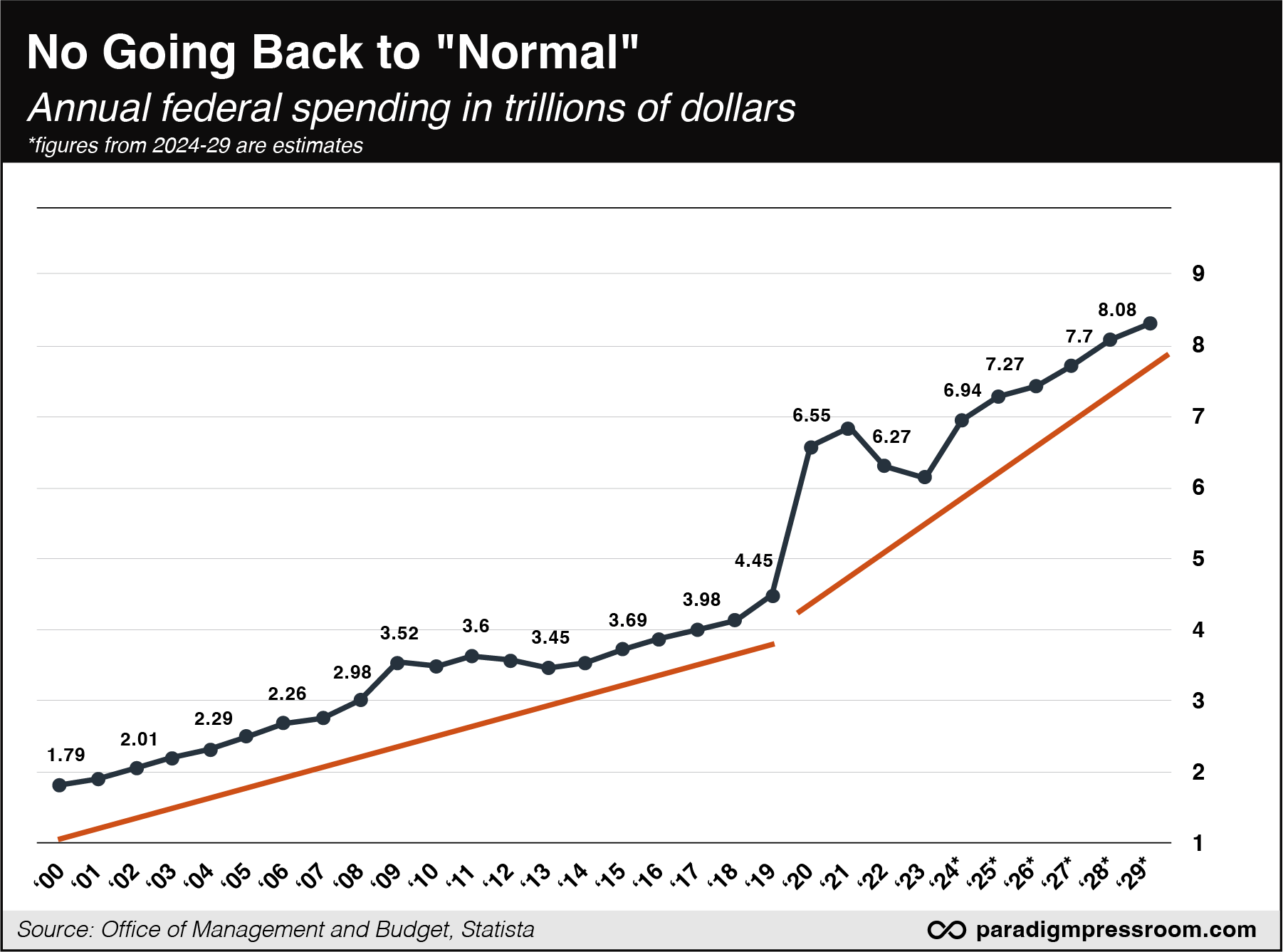Will the Big Banks Sabotage Trump’s Legacy?
![]() Will the Big Banks Sabotage Trump’s Legacy?
Will the Big Banks Sabotage Trump’s Legacy?
 Because the corporate media won’t tell you, it falls to us: Whether he realizes it or not, Donald Trump is sowing the seeds for a catastrophic bank failure during his second term.
Because the corporate media won’t tell you, it falls to us: Whether he realizes it or not, Donald Trump is sowing the seeds for a catastrophic bank failure during his second term.
And just like in 2008 and 2023… you’ll be left holding the bag.
The news broke yesterday. Here’s how CNBC framed it: “The Federal Reserve’s top banking regulator will be stepping down next month, paving the way for President-elect Donald Trump to name a replacement and heading off a potential confrontation between the two.”
The Wall Street Journal: “Vice Chair for Supervision Michael Barr, the agency’s top banking regulator, said he would resign from his position at the end of February, or sooner if President-elect Donald Trump appoints a successor.”
Both stories hint at the reason: “Members of the incoming Trump administration have expressed criticism of the Fed’s aggressive stance toward regulating banks,” says the WSJ. Similarly, CNBC points to “speculation that the new president wants someone who is more bank-friendly to take the role.”
 Missing from the mainstream coverage is this essential context: Barr was already very “bank-friendly” — so much so that his lack of oversight led to the second-, third- and fourth-largest bank failures in U.S. history.
Missing from the mainstream coverage is this essential context: Barr was already very “bank-friendly” — so much so that his lack of oversight led to the second-, third- and fourth-largest bank failures in U.S. history.
It started with Silicon Valley Bank in March 2023, climaxing with First Republic Bank two months later.
And yes, you personally were harmed by the Fed’s clean-up operations after these 2023 bank failures.
Because SVB had many politically connected depositors, the feds waived the $250,000 limit on FDIC deposit insurance — which was a huge drain on the FDIC’s insurance fund. To help replenish that fund, the feds ordered a “special assessment” on all banks — a cost passed along to you in the form of higher fees, commissions and anything else you pay your bank.
 “Why was Michael Barr not removed from office immediately after this historic failure?” asked our own Jim Rickards only days after SVB’s collapse.
“Why was Michael Barr not removed from office immediately after this historic failure?” asked our own Jim Rickards only days after SVB’s collapse.
“Instead, the Fed has ginned up its PR machine by pretending it was on the case all along.”
Indeed, the Fed planted a butt-covering story in The New York Times a week after SVB went down: “Silicon Valley Bank’s risky practices were on the Federal Reserve’s radar for more than a year,” it said.
“So what happened next?” Jim asked rhetorically. “The answer is nothing. The Fed sent a few warning letters and that was it. Why was the bank not taken over when these cash and control defects were spotted? At a minimum, why was management not replaced and immediate remedial steps implemented?”
But because this is Washington, D.C. we’re talking about, Barr kept his job.

Michael Barr: Because no one in Washington pays a price for failure.
[Federal Reserve photo]
To be sure, Barr was chastened by the experience. Once the dust settled in the summer of 2023, he proposed that banks start holding more cash on their balance sheets — the better to prevent more SVB-style meltdowns.
But as we chronicled last fall, the Wall Street big boys like JPMorgan Chase and Goldman Sachs put their lobbying clout to work inside the Beltway — and they browbeat Barr into watering down his proposal.
 If Barr was so hands-off that SVB et al. went down on his watch… and Trump wants someone even more hands-off… then another SVB-scale failure at minimum looks inevitable.
If Barr was so hands-off that SVB et al. went down on his watch… and Trump wants someone even more hands-off… then another SVB-scale failure at minimum looks inevitable.
Look, we’re all for deregulation in this e-letter. But not for the banks — not as long as they have a taxpayer backstop.
Recall that Trump became a viable candidate for president in 2016 in part because of lingering resentment over the events of 2008 — bailouts and rescues for the big banks, unemployment and foreclosures for regular folks.
But while Trump carried on with his “Mr. Outsider” persona during the 2024 campaign cycle, he quietly surrounded himself with more and more insider Wall Street types.
Cantor Fitzgerald CEO Howard Lutnick — host of a Hillary Clinton fundraiser in 2016 — was named co-chair of the transition team last August and is Trump’s choice for commerce secretary. Hedge fund manager Scott Bessent is the nominee for treasury secretary.
Last month, The Wall Street Journal cited Trump advisers as saying he “was more interested in New York financiers for top economic jobs.”
Presumably Trump doesn’t want a major bank failure to be part of his second-term legacy.
But unless someone inside his bubble warns him about what could happen if he’s too “bank-friendly”... that’s the risk he’s running.
![]() America’s “Liz Truss Moment”
America’s “Liz Truss Moment”
 Big risks by the big banks aren’t the only financial danger lurking in Trump’s second term.
Big risks by the big banks aren’t the only financial danger lurking in Trump’s second term.
You heard it here first last summer, before we knew who’d win the election: “Our own Liz Truss moment could easily arrive during the next president’s term.”
Truss was the hapless prime minister of the U.K. whose term lasted all of 49 days in 2022. What did her in was the “mini-budget” her cabinet submitted to Parliament — complete with generous energy subsidies and tax cuts. An already-yawning gap between revenue and expenses was set to widen further.
In short order, the pound fell to a record low against the U.S. dollar.
Much worse, confidence collapsed in British government debt — sending bond yields sky-high. The Bank of England had to step in and buy the bonds to prop up the market and prevent a possible default.

We hardly knew ye: Truss resigns after 44 days on Oct. 20, 2022
[Prime Minister’s Office photo]
Five months after our warning, Bloomberg chimes in this morning: “Treasury yields have been rising so fast that there’s a risk of bond market turmoil resembling the upheaval that led to the resignation of then British Prime Minister Liz Truss, according to Apollo Global Management’s Torsten Slok.”
 We pause briefly for some background.
We pause briefly for some background.
Last month we pointed out something that’s happening for the first time in over 40 years: The Federal Reserve is cutting short-term interest rates… but long-term interest rates are rising.
The benchmark 10-year Treasury yield was 3.62% in mid-September when the Fed started its rate-cutting cycle. This morning, it sits at 4.69% — very near a peak set last April. That suggests the bond market is sniffing out a resurgence of inflation during 2025.

Is the rise in yields a no-confidence vote in the Fed? Not necessarily, says Apollo’s Slok: “80% of the increase in long rates since September has potentially been driven by worries about fiscal policy,” he tells Bloomberg.
Fiscal policy is controlled by Congress and the president. The trajectory of federal spending is out of control — as you see in this chart we shared more than once last year.

Like in the U.K. in 2022, the gap between spending and revenue is becoming a yawning chasm. That too is something the bond market is sniffing out.
As colleague Sean Ring mentioned in yesterday’s Rude Awakening, rising bond yields can spill over into other asset classes — and put a hurt on the stock market.
No guarantees — but it’s something we’ve got an eye on.
![]() Busy Bankruptcy Courts
Busy Bankruptcy Courts
 More fallout from rising interest rates: Corporate bankruptcies sit at a 14-year high.
More fallout from rising interest rates: Corporate bankruptcies sit at a 14-year high.
Figures from S&P Global Market Intelligence reveal 686 U.S. companies filed for bankruptcy last year. That’s the highest since 2010 — when the economy was still climbing out of the “Great Recession.”
Among the big names were Party City, Tupperware, Red Lobster, Avon and Spirit Airlines.
The Financial Times pins the blame on “elevated interest rates and weakened consumer demand.” All else being equal, rising interest rates make it harder for businesses to borrow and fund their operations.
Look for more of this in the years to come. What the FT article didn’t say is that even if rates fall somewhat during 2025… we’re in the early years of a 40-year cycle in which the overall trend is up.
Most of us aren’t old enough to remember the last cycle, starting in the 1940s and ending in 1981.
Among the people who do remember are Berkshire Hathaway’s Warren Buffett, now 94 years old.
As it happens, Berkshire is sitting on a record amount of cash right now. Which means Buffett is being very choosy about what companies to invest in. Hmmm…
 Indeed the bond yields up, stock prices down dynamic is at work in the markets today.
Indeed the bond yields up, stock prices down dynamic is at work in the markets today.
When we left you yesterday the S&P 500 had recovered the 6,000 level. But it didn’t last and today the index is down another half percent to 5,945. The Dow is more or less flat but the Nasdaq is down over 1%.
Gold is climbing slowly, back over $2,650. Silver is holding on tight to the $30 level. Crude is over $74 for the first time since October.
Bitcoin’s hold on $100,000 had no staying power; it’s back below $98,000.
![]() AI-Generated Fake News
AI-Generated Fake News
 It seems Apple’s engineers need to work some bugs out of their AI effort called Apple Intelligence.
It seems Apple’s engineers need to work some bugs out of their AI effort called Apple Intelligence.
Among Apple Intelligence’s functions are summaries of breaking-news notifications. Unfortunately Apple’s AI engine is subject to the same “hallucinations” of other large language models…

Yeah, to the best of our knowledge, Luigi Mangione — the suspect in the murder of UnitedHealthcare CEO Brian Thompson — is still alive.
(I mean, you can’t rule out the prospect of him getting “Epsteined” in custody, but we’re not there yet!)
The BBC is understandably upset to see its name on fake news — well, fake news created by someone other than its own journalists!
The Beeb lodged a complaint last month but so far Apple is promising only to come up with some sort of clarification that its summaries are AI-generated.
![]() Clarification
Clarification
 The first entry in today’s mailbag is addressed to Paradigm AI authority James Altucher on the heels of his latest presentation.
The first entry in today’s mailbag is addressed to Paradigm AI authority James Altucher on the heels of his latest presentation.
“My question to you is with my original subscription purchase, before it expires, will I ever get the names of these companies before the buyout occurs with my subscription — or will each incident be just an opportunity to take advantage of your information if I pay over $1,900 right then to get the name of the Delaware tech company before the buyout is made public?
“I guess I expected to pay for your knowledge within my annual subscription, but not each time a financial buyout would cause me to have to pay more for each of Paradigm Press’ announcements of financial opportunities.
“Please help me to understand the process with these opportunities.”
 A more pointed message to the same effect also landed in our inbox.
A more pointed message to the same effect also landed in our inbox.
“Three thousand emails contained the same information about the possibly great trade with the company to be acquired by Nivida. However after clicking and watching, there was zero actionable information in any of the videos — name of company. I have time and time again wasted watching the teasers not just on this but prior opportunities. I tried to call in to customer service to get the information but the markets are now closed so it’s useless to me.
“I will be calling to cancel everything and then unsubscribing. Love the substantive information (especially Jim Rickards) but so tired of listening to wind-up time and time again with no actionable information.
“Very disappointed for the wasted time and money.”
 To the first reader, happy to help. And to the second, rest assured you haven’t wasted a thing.
To the first reader, happy to help. And to the second, rest assured you haven’t wasted a thing.
If you’re a subscriber to Altucher’s Investment Network, you’re getting your monthly issues complete with a stock recommendation — along with weekly updates from James on any news affecting the portfolio picks.
Now in recent days we’ve been bringing your attention to a different James publication — Altucher’s True Alpha.
Yes, it is a substantially higher-priced product — for several reasons.
To start with, the risk-reward ratio with the True Alpha recommendations is much higher. The aim is for a bigger payout in a shorter time compared with what you see in Altucher’s Investment Network. The higher price shuts out people who shouldn’t be taking on that level of risk.
In addition, the True Alpha recommendations are for options, not stocks. Options entail a greater degree of complexity than plain-vanilla stocks. The higher price shuts out beginners.
If you’re intrigued by the prospect of adding options to your investment mix, but you’re not sure where to start, we’ve published a report titled The Ultimate Beginner’s Guide to Stock Options: Everything You Need to Know to Buy, Sell and Profit From These Powerful Moneymakers. It’s yours to read, absolutely free, at this link.
So having said all that… the price of Nvidia shares is down 5.5% today after CEO Jensen Huang’s latest dog-and-pony show last night.
“Nvidia Slips After Product Event Leaves Investors Wanting More,” says a Bloomberg headline.
But James says that’s not the real story.
See, the AI tool that James uses in True Alpha just detected a “blue spike” for a Nvidia-adjacent company. Yes, it’s a tiny semiconductor firm based in Delaware.
Key point: It’s the same chart pattern that appeared before prior Nvidia buyouts.
Similar setups have led to potential gains as high as 2,350%... 5,133%... and even 7,100% — in only six days.
By following these “blue spikes,” Altucher’s True Alpha has secured a 74% win rate for the year.
That’s why James is so eager to have you watch his latest message.
As you might imagine, time is of the essence. For that reason we’re taking the message down tonight at midnight. If you want to give this opportunity a look, here’s your last chance.
Best regards,

Dave Gonigam
Managing editor, Paradigm Pressroom's 5 Bullets










